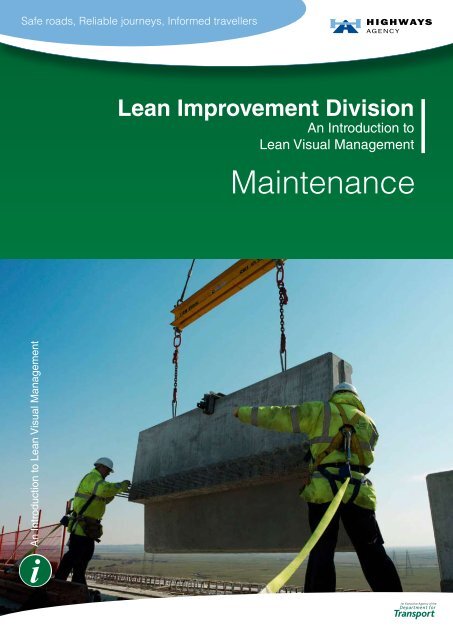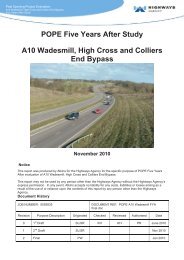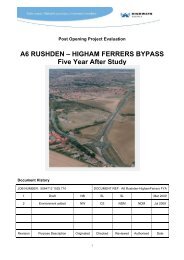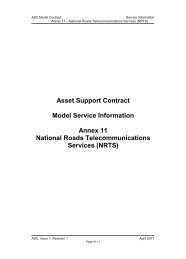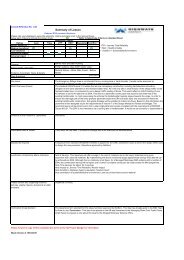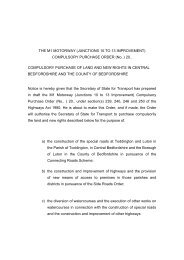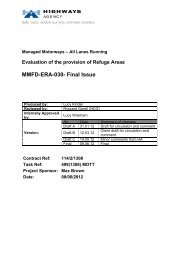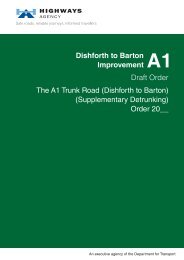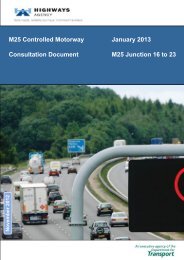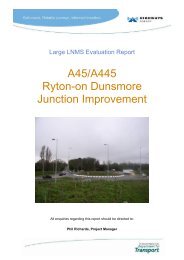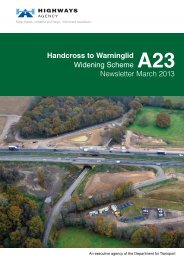Maintenance - Introduction to Lean Visual ... - Highways Agency
Maintenance - Introduction to Lean Visual ... - Highways Agency
Maintenance - Introduction to Lean Visual ... - Highways Agency
You also want an ePaper? Increase the reach of your titles
YUMPU automatically turns print PDFs into web optimized ePapers that Google loves.
Safe roads, Reliable journeys, Informed travellers<strong>Lean</strong> Improvement DivisionAn <strong>Introduction</strong> <strong>to</strong><strong>Lean</strong> <strong>Visual</strong> Management<strong>Maintenance</strong>An <strong>Introduction</strong> <strong>to</strong> <strong>Lean</strong> <strong>Visual</strong> Management
ForewordThe global financial crisis, the UK budget deficit, the Comprehensive SpendingReview, reductions in the <strong>Agency</strong>’s capital spending budget and an increasingdemand for travel.The above list reflects the environment we find ourselves in and the challenges weface. In order <strong>to</strong> overcome these challenges, whilst continuing <strong>to</strong> deliver a highquality of service <strong>to</strong> road users, we will have <strong>to</strong> deliver more for less.This is where lean comes in. The core principals of lean are the delivery of value -a recent report on behalf of HM Treasury has highlighted that the costs ofinfrastructure works in the UK are high in comparison with the rest of Europe - andthe elimination of waste - one of the guiding principles of the Compulsory SpendingReview was the elimination of waste.Within the <strong>Highways</strong> <strong>Agency</strong> we have begun <strong>to</strong> embrace <strong>Lean</strong> philosophy andpractices <strong>to</strong> enhance our intelligence as a client and reduce waste.In embracing <strong>Lean</strong> philosophy we are concentrating on our physical network asset,through maintenance, renewal and improvement activities. However, we believethe same <strong>Lean</strong> principles can and should be applied <strong>to</strong> the management anddelivery of our asset, increasing effectiveness and reducing waste <strong>to</strong> play asignificant role in making a positive contribution <strong>to</strong> the overall goal.We will further develop our role as an intelligent client and will expect andchallenge our suppliers <strong>to</strong> make <strong>Lean</strong> efficiencies against which quantitativebenefits can be realised. The <strong>Agency</strong> will also be looking for our suppliers <strong>to</strong>demonstrate their <strong>Lean</strong> capabilities. This demonstration, along with our StrategicAlignment Review Toolkit (StART), will form part of our supplier selection process.iAny printed copy of this document is considered uncontrolled. Controlled documents are maintainedelectronically and can be found on the <strong>Highways</strong> <strong>Agency</strong>’s PartnerNET at www.ha-partnernet.org.uk
ContentsAbout this Guidance NoteWhat’s in it for You?<strong>Lean</strong> <strong>Visual</strong> Management<strong>Visual</strong> DisplaysPerformance ImprovementStand-up MeetingsImplementing <strong>Lean</strong> <strong>Visual</strong> ManagementEnhancing <strong>Lean</strong> <strong>Visual</strong> ManagementFurther LearningAppendicesPage 1Page 2Page 3Page 5Page 10Page 17Page 22Page 25Page 26Page 27iiAny printed copy of this document is considered uncontrolled. Controlled documents are maintainedelectronically and can be found on the <strong>Highways</strong> <strong>Agency</strong>’s PartnerNET at www.ha-partnernet.org.uk
About this Guidance NoteThis guidance note is intended <strong>to</strong> provide an introduction <strong>to</strong> the concepts behind<strong>Lean</strong> <strong>Visual</strong> Management, a technique based on lean methodologies.It is aimed at members of the highways industry that already have a basicunderstanding of lean principles and wish <strong>to</strong> implement the use of the <strong>Lean</strong> <strong>Visual</strong>Management within their own organisations.<strong>Lean</strong> <strong>Visual</strong> Management complements other lean techniques including theCollaborative Planning System (see Enhancing <strong>Lean</strong> <strong>Visual</strong> Management onpage 25 of this guidance note). More information on the Collaborative PlanningSystem can be found on PartnerNET in ‘An <strong>Introduction</strong> <strong>to</strong> the CollaborativePlanning System’.Navigating this Guidance NoteThis guidance note uses colour coded page markers <strong>to</strong> easily distinguish betweenthe different sections of the document. These correspond <strong>to</strong> Figure 1 on page 4 ofthis document and can be found in the <strong>to</strong>p right hand corner of each page.Stand-up Meetings<strong>Lean</strong> <strong>Visual</strong> Management<strong>Visual</strong> DisplaysPerformance ImprovementPage 1Any printed copy of this document is considered uncontrolled. Controlled documents are maintainedelectronically and can be found on the <strong>Highways</strong> <strong>Agency</strong>’s PartnerNET at www.ha-partnernet.org.uk
What’s in it for You?The benefits of <strong>Lean</strong> <strong>Visual</strong> ManagementSuccessful <strong>Lean</strong> <strong>Visual</strong> Management can benefit teams by:■ Improving communication of key information■ Providing everyone in the team with the same picture■ Fostering collaboration, promoting teamwork and improving morale■ Providing a forum where all staff are able <strong>to</strong> raise any issues■ Helping the team identify and solve problems■ Measuring progress, identifying trends and analysing performance■ Focusing on and establishing goals for continuous improvement■ Providing performance information <strong>to</strong> validate the <strong>Highways</strong> <strong>Agency</strong>’s MST■ (Motivating Success Toolkit) submissionsI am moreinformed aboutcurrent issuesI am able <strong>to</strong>maximise the useof my timeI am more awareof how success ismeasuredI have a greaterunderstanding ofthe bigger picturePage 2Any printed copy of this document is considered uncontrolled. Controlled documents are maintainedelectronically and can be found on the <strong>Highways</strong> <strong>Agency</strong>’s PartnerNET at www.ha-partnernet.org.uk
<strong>Lean</strong> <strong>Visual</strong> ManagementCreating the right environment<strong>Lean</strong> <strong>Visual</strong> Management is based around communication, with teams working<strong>to</strong>gether <strong>to</strong> achieve clear shared goals. Subsequently, <strong>Lean</strong> <strong>Visual</strong> Managementworks best when:■ A collaborative form of contract exists that promotes improvement■ Leadership encourages and demonstrates working <strong>to</strong>gether■ Incentives are focused on improving the overall outcome■ Goals and the criteria for success are clearly defined■ A lean practitioner facilitates improvement■ All stakeholders contribute and are engaged in participation■ Teams are willing <strong>to</strong> positively embrace transparency■ Teams are prepared <strong>to</strong> be constructively honest yet direct with each other■ There is a commitment by all <strong>to</strong> learn■ A designated area is available <strong>to</strong> facilitate teams coming <strong>to</strong>gether■ Good facilitation skills are available <strong>to</strong> keep meetings concise and focused■ There is a willingness <strong>to</strong> jump in and learn by participationPage 3Any printed copy of this document is considered uncontrolled. Controlled documents are maintainedelectronically and can be found on the <strong>Highways</strong> <strong>Agency</strong>’s PartnerNET at www.ha-partnernet.org.uk
<strong>Lean</strong> <strong>Visual</strong> ManagementWhat is <strong>Lean</strong> <strong>Visual</strong> Management?<strong>Lean</strong> <strong>Visual</strong> Management is about communication and enabling teams <strong>to</strong> deliverperformance improvement over time. It involves doing three things:■ Using Primary <strong>Visual</strong> Displays (see Appendix B of this guidance note)■ Having Stand-up Meetings■ Seeking continuous Performance Improvement; by measuring, moni<strong>to</strong>ring and■reviewing team performanceTogether, these three actions provide a foundation upon which teams can begin <strong>to</strong>continuously improve.Figure 1 <strong>Lean</strong> <strong>Visual</strong> ManagementStand-upMeetingsPerformanceImprovement<strong>Visual</strong>DisplaysPage 4Any printed copy of this document is considered uncontrolled. Controlled documents are maintainedelectronically and can be found on the <strong>Highways</strong> <strong>Agency</strong>’s PartnerNET at www.ha-partnernet.org.uk
<strong>Visual</strong> DisplaysWhat are <strong>Visual</strong> Displays?<strong>Visual</strong> Displays are large central communication points focused around up <strong>to</strong>date team-specific information and continuous improvement activities.Typically, wall-mounted pin boards are used in combination with magnetic or drywipe boards. This allows regularly reported information, normally updated on aweekly or monthly basis, <strong>to</strong> be displayed alongside more dynamic information,which is updated daily. Examples of both dynamic and regularly reportedinformation are provided in the figure below.Figure 2 <strong>Visual</strong> DisplayDynamic information■ Safety issues■ Weather forecasts■ ISU movements■ Contact details■ Activity schedules■ Roadspace booking■ Shift handover notes■ News / RemindersRegularly reported information■ Health and safety information■ Programme / Cost information■ Permitted route working times■ Recent incidents■ Area Performance Indica<strong>to</strong>rs■ Continuous improvement activity■ Lessons learnedPage 5Any printed copy of this document is considered uncontrolled. Controlled documents are maintainedelectronically and can be found on the <strong>Highways</strong> <strong>Agency</strong>’s PartnerNET at www.ha-partnernet.org.uk
<strong>Visual</strong> DisplaysContentYour <strong>Visual</strong> Display should contain team-specific information related <strong>to</strong> thefollowing areas:■ People■ Performance■ Continuous improvementPeopleResource-orientated information is a key part of <strong>Lean</strong> <strong>Visual</strong> Managementbecause it facilitates day-<strong>to</strong>-day project delivery. Subsequently, it is vital that your<strong>Visual</strong> Display contains up <strong>to</strong> date information about the team.Information should cover areas such as:■ Who is in the depot?■ What are they scheduled <strong>to</strong> be doing?■ When are they scheduled <strong>to</strong> be doing it?■ Are there any issues currently preventing them from successful completion?■ Are there any hazards / risks that people should be aware of?Displaying this information on a <strong>Visual</strong> Display provides everyone with the samepicture of what everyone else is doing at all times. This helps the team <strong>to</strong> identifypotential problems early and thus mitigate any associated time, cost and safetyimplications.Performance<strong>Visual</strong> Displays play a key role in communicating up <strong>to</strong> date performanceinformation <strong>to</strong> the team. Displaying this information focuses team members ontheir immediate targets and helps them <strong>to</strong> understand how their individualperformance can contribute <strong>to</strong> overall success.Page 7Any printed copy of this document is considered uncontrolled. Controlled documents are maintainedelectronically and can be found on the <strong>Highways</strong> <strong>Agency</strong>’s PartnerNET at www.ha-partnernet.org.uk
<strong>Visual</strong> DisplaysA team’s <strong>Visual</strong> Display is a reflection of that team. It is therefore important thatteam members are able <strong>to</strong> easily relate their individual performance <strong>to</strong> theinformation on display. This leads <strong>to</strong> greater ownership and commitment. Teamswill also take more pride in their performance when they can see the impact of ‘ajob well done’.On this basis, information should be relevant <strong>to</strong> the team and communicated in away that allows the team <strong>to</strong> see the contribution they are making. One of thesimplest ways <strong>to</strong> achieve this is through the use of regularly reported performancemeasures.The importance of performance measuresIn order <strong>to</strong> understand the importance of performance measures, it is useful <strong>to</strong>understand why we produce these measures in the first place.Put simply, performance measures help <strong>to</strong> answer the question: “How are wedoing?”. Without performance measures you can’t fully understand how well youare doing because there nothing <strong>to</strong> tell you if your performance is good or if yourperformance is bad. Subsequently, you have no way of measuring whether or notyour performance has improved over time because you have nothing <strong>to</strong> compareyour performance against - you will have no baseline for improvement.Choosing the right performance measuresIt is very important that the right performance measures are chosen if improvementis <strong>to</strong> be achieved. When choosing suitable measures for your team it is useful <strong>to</strong>consider the following questions:■ Is the measure important <strong>to</strong> the cus<strong>to</strong>mer?■ Is the measure easy <strong>to</strong> understand?■ Is data available that will allow the measure <strong>to</strong> be updated on a regular basis?■ Can the team relate <strong>to</strong> it? Will they gain satisfaction from improvement?■ Can improvements be tracked and captured easily?Page 8Any printed copy of this document is considered uncontrolled. Controlled documents are maintainedelectronically and can be found on the <strong>Highways</strong> <strong>Agency</strong>’s PartnerNET at www.ha-partnernet.org.uk
<strong>Visual</strong> DisplaysExamplesExamples of performance information that might be used <strong>to</strong> develop measures,and which are aligned with the <strong>Agency</strong>’s Motivating Success Toolkit, are:■ Product: CAT 1 Defect response time■ Product: Lane availability■ Product: Incident response time■ Service: Number of maintenance interventions■ Service: Number of complaints■ Right First Time: Number of defects■ Cost: Actual cost against cost forecast■ Time: Actual time against time forecast■ Safety: All Accident Frequency RateContinuous Improvement<strong>Visual</strong> Displays provide information and <strong>to</strong>ols that facilitate continuousperformance improvement at a team-level. Continuous improvement activity is akey part of <strong>Lean</strong> <strong>Visual</strong> Management and team performance is unlikely <strong>to</strong>improve without it. Information and <strong>to</strong>ols include:■ Current performance measures■ Improvement Suggestion SystemsPage 9Any printed copy of this document is considered uncontrolled. Controlled documents are maintainedelectronically and can be found on the <strong>Highways</strong> <strong>Agency</strong>’s PartnerNET at www.ha-partnernet.org.uk
Performance ImprovementImprovement Suggestion SystemsImprovement Suggestion Systems are continuous improvement <strong>to</strong>ols thatsupport <strong>Visual</strong> Displays and Stand-up Meetings by providing teams with astructured approach <strong>to</strong> realising performance improvements.What do they involve?Improvement Suggestion Systems involve the capture of any practicalimprovement suggestions that are generated by the team. These suggestions willnormally be driven by off-target or static performance measures identified by theteam and highlighted at daily Stand-up Meetings (see example agenda on page21 of this guidance note).It is recommended that suggestions arefocused on simple, low-tech solutions thatcan be implemented by the team withoutthe intervention of senior management.Suggestions that are implemented by theteam can be considered as ‘banked’,providing a platform for the nextimprovement. By continuing <strong>to</strong> capture and‘bank’ small incremental gains teams willbegin <strong>to</strong> see that it is possible <strong>to</strong> realisesignificant improvements in performance.ImprovementThere are various methods teams can employ <strong>to</strong> capture improvementsuggestions and teams are encouraged <strong>to</strong> try various methods in order <strong>to</strong>ascertain those that work best for them. However, two of the most commonapproaches are:■ Concern, Cause & Countermeasure (3C)■ The Four Folder Approach (4FA)Page 10Any printed copy of this document is considered uncontrolled. Controlled documents are maintainedelectronically and can be found on the <strong>Highways</strong> <strong>Agency</strong>’s PartnerNET at www.ha-partnernet.org.uk
Performance ImprovementConcern, Cause & Countermeasure (3C)Concern, Cause & Countermeasure is a simple, table-based approach <strong>to</strong>capturing improvement suggestions generated by the team. An example Concern,Cause & Countermeasure table that can be used on a team’s <strong>Visual</strong> Display isprovided in Appendix A of this guidance note.Where do I start?Initial suggestions submitted under Concern, Cause & Countermeasure arenormally aimed at addressing concerns raised by senior management or off-targetArea Performance Indica<strong>to</strong>rs. Issues raised at this level are more likely <strong>to</strong> reflectwhat matters <strong>to</strong> your cus<strong>to</strong>mer, and delivering maximum value <strong>to</strong> the cus<strong>to</strong>mer is afundamental part of lean.Suggestions should also be driven by the continuous review of team performance.All off -target performance measures should be raised as a concern on theConcern, Cause & Countermeasure form and subsequent appropriate actiontaken.In the example provided, the first column of the Concern, Cause &Countermeasure form is used <strong>to</strong> provide a reference number for each concernraised while the second column is used <strong>to</strong> provide a brief description of theconcern in question. These two columns will normally be populated by the teamsupervisor based on concerns passed down by senior management. These maybe concerns about specific issues, such as a recent accident or incident, ordownward trends in Area Performance Indica<strong>to</strong>rs. The third and forth columns areused <strong>to</strong> record the date the concern was raised and the name of the person whoraised the concern, allowing progress <strong>to</strong> be tracked.The fifth column is used <strong>to</strong> record the perceived cause behind a specific concern.For example, a concern about a rise in slips, trips and falls in a depot might beperceived <strong>to</strong> be caused by untidiness. This column is also normally populated bythe supervisor. However, it is recommended that the rest of the team beencouraged <strong>to</strong> add their own ideas <strong>to</strong> the cause column as they are likely <strong>to</strong> havedifferent views about causes when compared <strong>to</strong> those of supervisors and seniormanagement.Page 11Any printed copy of this document is considered uncontrolled. Controlled documents are maintainedelectronically and can be found on the <strong>Highways</strong> <strong>Agency</strong>’s PartnerNET at www.ha-partnernet.org.uk
Performance ImprovementThe sixth column of the Concern, Cause & Countermeasure form is used <strong>to</strong>record the agreed countermeasure.The seventh column is used <strong>to</strong> record the name of the person, or persons, who areresponsible for instigating, undertaking and completing the actions associated withthe agreed countermeasure.The eighth column should be used <strong>to</strong> identify an agreed target date for completionof countermeasure actions and the ninth column should be used <strong>to</strong> record thestatus of the countermeasure actions in relation the target date.The tenth and final column should be used <strong>to</strong> record the results of thecountermeasure and the information provided in this column should be aimed atanswering the following questions:■ Was the countermeasure successful? If not, why not?■ What was the result of implementing the countermeasure?■ Did performance increase? If so, by how much?■ Did performance increase in areas other than those expected? If so, why?■ Were there any lessons learnt? If so, what were they and how are they being■ communicated?Page 12Any printed copy of this document is considered uncontrolled. Controlled documents are maintainedelectronically and can be found on the <strong>Highways</strong> <strong>Agency</strong>’s PartnerNET at www.ha-partnernet.org.uk
Performance ImprovementThe Four Folder ApproachThe Four Folder Approach is also aimed at capturing improvement suggestionsgenerated by the team. Using the Four Folder Approach allows teams <strong>to</strong>:■ Capture ideas that fall ‘below the radar’ of other organisation-wide initiatives■ Provide team members with an opportunity <strong>to</strong> influence the way that■ they work■ Provide a means of identifying and capturing small changes that help■ eliminate waste at its sourceHow does the Four Folder Approach work?As its name suggests this approach is based around the use of four folders thatform part of a team’s <strong>Visual</strong> Display. These are:■ A folder containing blank suggestion forms■ A folder for submitted suggestions■ A folder for instigated suggestions■ A folder for completed suggestions1. BlankSuggestionForms2. SubmittedSuggestions3. InstigatedSuggestions4. CompletedSuggestionsPage 13Any printed copy of this document is considered uncontrolled. Controlled documents are maintainedelectronically and can be found on the <strong>Highways</strong> <strong>Agency</strong>’s PartnerNET at www.ha-partnernet.org.uk
Performance ImprovementThe first step requires a member of the team <strong>to</strong> take a blank suggestion form fromthe first folder. They should then write down their suggestion and place their formthe second folder.1. BlankSuggestionForms2. SubmittedSuggestionsAny submitted improvement suggestions should then be reviewed at the nextStand-up Meeting. During the meeting team supervisors should reviewsuggestions with their teams and agree the appropriate action <strong>to</strong> be taken. Theteam supervisor may want <strong>to</strong> review suggestions ahead of the Stand-up Meetingdepending on the number submitted.2. SubmittedSuggestions3. InstigatedSuggestionsPage 14Any printed copy of this document is considered uncontrolled. Controlled documents are maintainedelectronically and can be found on the <strong>Highways</strong> <strong>Agency</strong>’s PartnerNET at www.ha-partnernet.org.uk
Performance ImprovementBefore moving suggestions from the second folder <strong>to</strong> the third folder teamsupervisors should agree one of the following actions with the team.■ Agree <strong>to</strong> instigate and undertake the improvement suggestion themselves■ Ask if any member of the team would like <strong>to</strong> instigate and implement the■ improvement suggestion forward on the team supervisors behalf■ Nominate a member of the work group <strong>to</strong> instigate and implement the■ improvement action on the team supervisors behalf■ Agree with the team that the improvement action is not feasible and should not■ be instigated■ Agree with the team that the improvement suggestion is ‘<strong>to</strong>o big’ <strong>to</strong> be■ instigated by the team alone and should be submitted <strong>to</strong> senior management■ for consideration.Only when improvement actions have been implemented and the results ofimplementation have been recorded can the suggestion be moved from the thirdfolder <strong>to</strong> the fourth and final folder.3. InstigatedSuggestions4. CompletedSuggestionsPage 15Any printed copy of this document is considered uncontrolled. Controlled documents are maintainedelectronically and can be found on the <strong>Highways</strong> <strong>Agency</strong>’s PartnerNET at www.ha-partnernet.org.uk
Performance ImprovementThe recording of implementation results should be aimed at answering thefollowing questions:■ Was the suggestion successful? If not, why not?■ What was the result of implementing the suggestion? Did performance■ increase? If so, by how much?■ Did performance increase in areas other than those expected? Why?■ Were there any lessons learnt? If so, what were they and how are they being■ communicated?Key pointsImprovement Suggestion Systems:■ Form part of a team’s <strong>Visual</strong> Display■ Are discussed at daily Stand-up Meetings■ Are driven by team performance measures and suggestions focused on■ raising areas of underachievement■ Focus on solutions that can be implemented by the teamPage 16Any printed copy of this document is considered uncontrolled. Controlled documents are maintainedelectronically and can be found on the <strong>Highways</strong> <strong>Agency</strong>’s PartnerNET at www.ha-partnernet.org.uk
Stand-up MeetingsMore than a notice boardIt is important <strong>to</strong> remember that <strong>Lean</strong> <strong>Visual</strong> Management is much more thansimply having a Primary <strong>Visual</strong> Display that simply displays information in thesame way a notice board would.Notice boards only provide a passive, one-way flow of information, from the board<strong>to</strong> the viewer. <strong>Lean</strong> <strong>Visual</strong> Management is different in that it requires teams <strong>to</strong>interact with their Primary <strong>Visual</strong> Display on a regular basis so that it becomes afocal point for team interaction and improvement activity. Under <strong>Lean</strong> <strong>Visual</strong>Management this interaction is facilitated by Stand-up Meetings.Figure 3 <strong>Visual</strong> Display InteractionAmendingkey datesHighlighting offtarget performanceReviewinglessons learnedChecking theday’s activitiesProviding suggestionsfor improvementPage 17Any printed copy of this document is considered uncontrolled. Controlled documents are maintainedelectronically and can be found on the <strong>Highways</strong> <strong>Agency</strong>’s PartnerNET at www.ha-partnernet.org.uk
Stand-up MeetingsWhat are Stand-up Meetings?Stand-up Meetings are regular, manda<strong>to</strong>ry meetings held in front of a team’s<strong>Visual</strong> Display. The purpose of a Stand-up Meeting is two-fold:■ They provide a forum where teams discuss their progress on a regular basis■ and make work commitments■ They provide a forum where teams review performance measures and the■ progress of improvement actionsTeams are deliberately required <strong>to</strong> stand <strong>to</strong> ensure that meetings are kept short. Inaddition Stand-up Meetings should be:■ Attended by all members of the team■ Kept brief (ideally between 10 and 15 minutes long)■ Held at a regular time■ Follow a set agenda (see page 21 of this guidance note)Page 18Any printed copy of this document is considered uncontrolled. Controlled documents are maintainedelectronically and can be found on the <strong>Highways</strong> <strong>Agency</strong>’s PartnerNET at www.ha-partnernet.org.uk
Stand-up Meetings<strong>Visual</strong> Displays are an integral part of team Stand-up Meetings. A team’s <strong>Visual</strong>Display therefore needs <strong>to</strong> present all of the information that needs <strong>to</strong> beaddressed by the team.Stand-up Meetings should be held daily. Where this is not feasible, or where workis intermittent (for example, where only weekend working is involved), lessfrequent (possibly longer) meetings can be held.For example, a team that only works weekends would have a meeting on aThursday or Friday in which they plan the entire weekends work. This will befollowed by Stand-up Meetings on the Saturday and Sunday, which are followedup by another meeting on the Monday <strong>to</strong> review the entire weekends performance.Where shift changes occur, handover notes on a team’s <strong>Visual</strong> Display are anideal way of updating the incoming shift in the absence of daily Stand-upMeetings. Notes may include progress made, any changes <strong>to</strong> the situation on site,or any potential safety issues.The benefits of Stand-up MeetingsThe benefits associated with Stand-up Meetings include:■ Bringing the team <strong>to</strong>gether and facilitating teamwork■ Providing every member of the team with the opportunity <strong>to</strong> contribute■ Providing every member of the team with same clear picture of what is■ happening■ Highlighting potential issues■ Focusing each member of the team on productivity and performance measuresPage 19Any printed copy of this document is considered uncontrolled. Controlled documents are maintainedelectronically and can be found on the <strong>Highways</strong> <strong>Agency</strong>’s PartnerNET at www.ha-partnernet.org.uk
Stand-up MeetingsWhat do they involve?Stand-up Meetings require teams <strong>to</strong> do four things:■ Review the previous days performance■ Plan the current day’s workload (assign and distribute work assignments)■ Identify obstacles <strong>to</strong> progress■ Discuss areas of underperformance, and any subsequent improvement actionsOne way of doing this is <strong>to</strong> allow each team member <strong>to</strong> take turns in providing aprogress update <strong>to</strong> the rest of the team. Updates should be kept brief and shouldanswer the following three questions:■ What did I do yesterday? Or: Did I meet my commitments yesterday?■ What am I doing <strong>to</strong>day? Or: What can I commit <strong>to</strong> <strong>to</strong>day?■ What obstacles are preventing me from making progress? Or: What is■ preventing me from meeting my commitments?It is important that Stand-up Meetings focus on the main issues of the day. Moredetailed discussions, which may be required <strong>to</strong> resolve a particular issue, shouldtake place outside the Stand-up Meeting so as not <strong>to</strong> interrupt flow. For thisreason it is important that there is an agenda and that the team adhere <strong>to</strong> thatagenda.Page 20Any printed copy of this document is considered uncontrolled. Controlled documents are maintainedelectronically and can be found on the <strong>Highways</strong> <strong>Agency</strong>’s PartnerNET at www.ha-partnernet.org.uk
Stand-up MeetingsStand-up Meetings follow the example agenda below:Agenda1. Team update (All)1a. Yesterday’s progress1b. Today’s commitments1c. Obstacles / Issues2. Review performance3. measures (highlighting3. any concerns)3. Review performance6. improvement progress and4. team suggestionsKey pointsStand-up Meetings:■ Are held in front of the team’s <strong>Visual</strong> Display■ Are short■ Review team performance against relevant performance measures■ Review continuous improvement activity■ Should end with a safety briefingPage 21Any printed copy of this document is considered uncontrolled. Controlled documents are maintainedelectronically and can be found on the <strong>Highways</strong> <strong>Agency</strong>’s PartnerNET at www.ha-partnernet.org.uk
Implementing <strong>Lean</strong> <strong>Visual</strong> ManagementStructure<strong>Lean</strong> <strong>Visual</strong> Management is based on the concept of teams. To ensuresuccessful implementation of the <strong>Lean</strong> <strong>Visual</strong> Management you should givecareful consideration <strong>to</strong> what constitutes a team with respect <strong>to</strong> your specificworking environment. Generally, teams should comprise a group of 7±2individuals, working in close proximity, who share many of the same goals andobjectives.It should be noted that both <strong>Visual</strong> Displays and Stand-up Meetings have theability <strong>to</strong> function across work of varying degrees of size and complexity and atvarious levels of management and seniority.For example, if you have a small workpackage that only involves a single team,you will only need one <strong>Visual</strong> Display. Inthis case the team supervisor will beresponsible for facilitating Stand-upMeetings and reporting progress <strong>to</strong>senior management on a regular andongoing basis.Larger and more complex work packages that involve substantial multidisciplinaryinteraction may require each team <strong>to</strong> have their own <strong>Visual</strong> Display. In cases likethis a team’s <strong>Visual</strong> Display is likely <strong>to</strong> be more discipline-centric, with each teamhaving their own individual board that contains project information relevant <strong>to</strong> them.The team supervisor will still facilitate Stand-up Meetings with their individualteams but they may also participate in meetings with other team supervisors inorder <strong>to</strong> disseminate and discuss cross-management issues. This meeting mayutilise a <strong>Visual</strong> Display that provides information more pertinent <strong>to</strong> seniormanagement. Where this is the case, teams should be encouraged <strong>to</strong> also highlightissues that have the potential <strong>to</strong> affect colleagues or stakeholders outside theimmediate team, so that these can reported upward.Structure is an important fac<strong>to</strong>r in <strong>Lean</strong> <strong>Visual</strong> Management and carefulconsideration should be given <strong>to</strong> this prior <strong>to</strong> implementation.Page 22Any printed copy of this document is considered uncontrolled. Controlled documents are maintainedelectronically and can be found on the <strong>Highways</strong> <strong>Agency</strong>’s PartnerNET at www.ha-partnernet.org.uk
Implementing <strong>Lean</strong> <strong>Visual</strong> ManagementImplementing <strong>Lean</strong> <strong>Visual</strong> ManagementThe first step in implementing <strong>Lean</strong> <strong>Visual</strong> Managementis the determination and measurement of appropriateteam-specific performance measures so that the teamcan determine their baseline for improvement.Determine thebaseline forimprovementOnce suitable performance measures have beendetermined, teams can begin <strong>to</strong> develop their individual<strong>Visual</strong> Displays. This development will focus on theagreement of the information that best informs the teamand which will enable performance improvement activity.Developthe <strong>Visual</strong>DisplayWhen teams have their <strong>Visual</strong> Displays in place, theycan begin <strong>to</strong> hold regular Stand-up Meetings. Teams willsoon become familiar with Stand-up Meetings and theiruse will start <strong>to</strong> become second nature.HoldStand-upMeetingsAs the use of Stand-up Meetings matures, teams willfind that they are spending less and less time reportingindividual progress updates and more time focusing onperformance measures and improvement activity - due <strong>to</strong>the increased efficiency of meetings over time.Focus onperformanceimprovementWhen teams reach a position where performancemeasures and improvement activity are a part of theirdaily routine they need <strong>to</strong> ensure Stand-Meetings and<strong>Visual</strong> Displays are maintained and that performanceimprovement continues - teams should periodically reviewteam performance against the original baseline forimprovement <strong>to</strong> see what has been achieved <strong>to</strong> date.MaintainPage 23Any printed copy of this document is considered uncontrolled. Controlled documents are maintainedelectronically and can be found on the <strong>Highways</strong> <strong>Agency</strong>’s PartnerNET at www.ha-partnernet.org.uk
Implementing <strong>Lean</strong> <strong>Visual</strong> ManagementThings you might hearThere are a number of phases that you might hear when first implementing <strong>Lean</strong><strong>Visual</strong> Management. These are normally based on the perceptions (andmisconceptions) of people before engagement, education and training (which iswhy these are so important <strong>to</strong> successful implementation). It is worth rememberingthat people normally have a healthy scepticism about new ideas that onlymanifests itself because they want <strong>to</strong> be sure that those ideas are sound.This won’twork hereThe idea that <strong>Lean</strong> is only suited <strong>to</strong> manufacturingprocesses is a common misconception. Since itsinception, <strong>Lean</strong> methodology has been successfullyadopted across a wide range of industries includingaerospace, engineering, finance, research anddevelopment, and marketing.<strong>Lean</strong> is not a new concept, but one which has been aroundsince the early part of the 20 th century. Many of the <strong>to</strong>ols thatare associated with modern <strong>Lean</strong> techniques were developedin the Japanese au<strong>to</strong>motive industry at the end of the SecondWorld War. Since then, <strong>Lean</strong> methodology has proven itselfaround the world.This is justanother fadI will have <strong>to</strong>work harderand faster<strong>Lean</strong> isn’t about increasing the pace of work. It is aboutincreasing productivity by establishing ways in whichteams can work more efficiently, both individually andcollectively.Page 24Any printed copy of this document is considered uncontrolled. Controlled documents are maintainedelectronically and can be found on the <strong>Highways</strong> <strong>Agency</strong>’s PartnerNET at www.ha-partnernet.org.uk
Enhancing <strong>Lean</strong> <strong>Visual</strong> ManagementWhile <strong>Lean</strong> <strong>Visual</strong> Management can be used as a standalone technique, thebenefits it delivers can be enhanced by the Collaborative Planning System. Thefigure below shows how these two techniques complement one another.ProductionControlPROVIDES PERFORMANCEINFORMATION AND ENHANCESTHE QUALITY OF WORKASSIGNMENTSStand-upMeetingsCollaborativeMappingProcessImprovementPerformanceImprovement<strong>Visual</strong>DisplaysCONTINUOUS IMPROVEMENT ACTIVITYAt its core, the Collaborative Planning System is focused on planning <strong>to</strong> dowork. Similarly, <strong>Lean</strong> <strong>Visual</strong> Management is focused on putting people <strong>to</strong> work.The quality of work assignments distributed via Stand-up Meetings can beenhanced through the use of Production Control techniques by ensuring that allinputs, controls and resources required <strong>to</strong> successfully complete assignments arein place prior <strong>to</strong> starting work.In addition, Process Improvement and Performance Improvement techniqueswork <strong>to</strong>gether because they are both focused on continuous improvement activity.Together, they provide teams with set of <strong>to</strong>ols with which <strong>to</strong> add value and reducewaste.Page 25Any printed copy of this document is considered uncontrolled. Controlled documents are maintainedelectronically and can be found on the <strong>Highways</strong> <strong>Agency</strong>’s PartnerNET at www.ha-partnernet.org.uk
Further LearningWhere can I get more information?Additional information, including Knowledge Transfer Packs, can be found on the<strong>Highways</strong> <strong>Agency</strong>’s PartnerNET at www.ha-partnernet.org.uk. These KnowledgeTransfer packs illustrate where these <strong>Lean</strong> techniques have been used on realexample projects / situations.Further information on the Collaborative Planning System can also be found onPartnerNET as well as HA <strong>Lean</strong> Success S<strong>to</strong>ries including:■ <strong>Lean</strong> Daily Management System■ <strong>Visual</strong> Management (See Appendix B)■ Collaborative PlanningPage 26Any printed copy of this document is considered uncontrolled. Controlled documents are maintainedelectronically and can be found on the <strong>Highways</strong> <strong>Agency</strong>’s PartnerNET at www.ha-partnernet.org.uk
AppendicesAppendix A: Example Concern,Cause and Countermeasure (3C) tablePage 27Any printed copy of this document is considered uncontrolled. Controlled documents are maintainedelectronically and can be found on the <strong>Highways</strong> <strong>Agency</strong>’s PartnerNET at www.ha-partnernet.org.uk
AppendicesAppendix B: HA <strong>Lean</strong> Success S<strong>to</strong>ry - <strong>Visual</strong> ManagementPage 28Any printed copy of this document is considered uncontrolled. Controlled documents are maintainedelectronically and can be found on the <strong>Highways</strong> <strong>Agency</strong>’s PartnerNET at www.ha-partnernet.org.uk
© Crown copyright 2010. You may re-use this information (not including logos) free of charge in anyformat or medium, under the terms of the Open Government Licence. To view this licence, visithttp://www.nationalarchives.gov.uk/doc/open-government-licence/ or write <strong>to</strong> the Information PolicyTeam, The National Archives, Kew, London TW9 4DU, or e-mail: psi@nationalarchives.gsi.gov.uk.This document/publication is also available on our website at www.highways.gov.ukAny enquiries regarding this document/publication should be sent <strong>to</strong> us atha_info@highways.gsi.gov.uk or call 0300 123 5000<strong>Highways</strong> <strong>Agency</strong> Publications Group, Leeds n100173For wider mo<strong>to</strong>ring advice visit Directgovwww.direct.gov.uk/mo<strong>to</strong>ring


